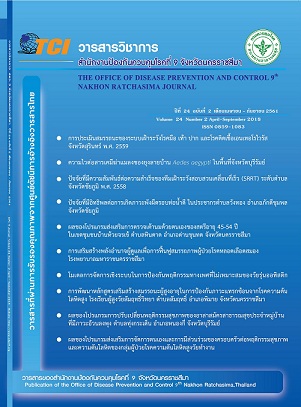The Curriculum Development for Strengthening the Elderly’s Competencies on Prevention of Complications from Hypertension at Phoosungwai Samrit Wittaya School, Phimai District, Nakhon Ratchasima Province
Keywords:
curriculum, competency, health, hypertension, elderlyAbstract
This research was a Participatory Action Research (PAR). The aims of this research were to:
1) develop a curriculum that help the elderly strengthen their competencies on prevention of complications
from hypertension; and 2) evaluate the effectiveness of the course. There were three phases of study
including: 1) collection of essential baseline data using in-depth interviews; 2) curriculum development
that consisted of four steps, such as plan, action, observation, and reflaction; and 3) curriculum
improvement. The quantitative data were analyzed using descriptive statistics, such as mean, percentage,
standard deviation; while qualitative data were analyzed using content analysis. The results showed that
1) The curriculum for strengthening the elderly’s competencies on prevention of complications from
hypertension in Phoosungwai Samrit Wittaya School, Phimai District, Nakhon Ratchasima Province
consisted of 11 elements, including philosophy, vision, mission, goals, desirable characteristics,
learning content, structure and time, learning standards, media and learning resources, and measurement
and evaluation. 2) The curriculum’s effectiveness evaluated by CIPP Model found that the overall
effectiveness was at the highest level with mean was 4.54 (S.D. = 0.421), especially in the context
and product aspects that were at the highest level with both means were 4.61 (S.D. = 0.379 and
0.410, respectively). Therefore, it can be seen that the curriculum development for the elderly
which concerned the needs of students and community context significantly inflf iuenced their successful
learning in the ageing school. It helped the older people develop their knowledge and skills on
self-care, which would support the elderly to continue their better health and quality of life.
References
[เข้าถึงเมื่อวันที่ 12 มกราคม 2559]. เข้าถึงได้จาก : http//nso.go.th.
2. ปราโมทย์ ปราสาทกุล. สถานการณ์ผู้สูงอายุไทย พ.ศ. 2558. กรุงเทพฯ : บริษัทอัมรินทร์พริ้นติ้ง แอนด์
พับลิชชิ่ง จำกัด (มหาชน), 2559 ; 6-7.
3. วิมล บ้านพวน. คู่มือแนวทางการฝึกอบรม หลักสูตร Care manager. (พิมพ์ครั้งที่ 2). กรุงเทพฯ : ศูนย์สื่อ
และสิ่งพิมพ์แก้วเจ้าจอม มหาวิทยาลัยราชภัฎสวนสุนันทา, 2558 ; 11-15.
4. เจิมศักดิ์ ปิ่นทอง. การปฏิรูประบบรองรับสังคมสูงวัย. กรุงเทพฯ: โอเดียนสโตร์, 2558 : 7-9.
5. สำนักงานสาธารณสุขจังหวัดนครราชสีมา. ข้อมูลจากการคัดกรอง ADL 2559. [อินเทอร์เน็ต] [เข้าถึงเมื่อ
วันที่ 14 มกราคม 2559]. เข้าถึงได้จาก http://www.korathealth.com/korathealth/download/
download_view.php?id=127&w=list&page_=3&pages=.
6. ศูนย์ข้อมูลประเทศไทย. ข้อมูลประชากรอำเภอพิมาย จังหวัดนครราชสีมา. [อินเทอร์เน็ต] [เข้าถึงเมื่อวันที่
12 มกราคม 2559]. เข้าถึงได้จาก http://nakhonratchasima.kapook.com/ %E0%B8%9E%E0
%B8%B4%E0%B8%A1%E0%B8%B2%E0%B8%A2
7. โรงพยาบาลส่งเสริมสุขภาพตำบลบ้านซึม. แบบรายงานข้อมูลประชากร. นครราชสีมา, 2559.
8. Kemmis,S.and Mctaggart,C. The action research planner .3rd ed. DeakinUniversity : Victoria, 1990.
9. สุรีพันธ์ วรพงศธร. การวิจัยทางสุขศึกษา = Research in health education. กรุงเทพมหานคร : โรงพิมพ์
วิฑูรย์การปก, 2558 ; 29-36.
10. ธนายุส ธนธิติและกนิษฐา จำรูญสวัสดิ์. การพัฒนาพฤติกรรมการดูแลสุขภาพที่พึงประสงค์ของผู้สูงอายุ
ในชมรมผู้สูงอายุตำบลบางเตย อำเภอสามพราน จังหวัดนครปฐม. วารสารพยาบาลสงขลานครินทร์
2558 ; 35 : 57-70.
11. คมกริช หุตวัฒนะ. การพัฒนารูปแบบการสร้างเสริมสุขภาพของสมาชิกชมรมผู้สูงอายุ ตำบลพันชนะ
อำเภอด่านขุนทด จังหวัดนครราชสีมา มหาบัณฑิต สาขาการพัฒนาสุขภาพชุมชน (รายงานการวิจัย).
นครราชสีมา: มหาวิทยาลัยราชภัฏนครราชสีมา, 2553.
12. เพ็ญจันทร์ สิทธิปรีชาชาญ, ปนัดดา ปริยฑฤฆและ ญาณิศา โชติกะคาม. กระบวนการดูแลสุขภาพผู้สูงอายุ
อย่างมีส่วนร่วมของชุมชนตำบลมาบแค. วารสารพยาบาลทหารบก 2555 : 13 : 8-17.
13. สถาบันวิจัยและประเมินเทคโนโลยีทางการแพทย์ กรมการแพทย์ กระทรวงสาธารณสุข. เอกสารข้อมูล:
สถานการณ์โรคเบาหวาน/ความดันโลหิตสูงและภาวะแทรกซ้อนในประเทศไทย. [อินเทอร์เน็ต]
[เข้าถึงเมื่อวันที่ 14 มกราคม 2559]. เข้าถึงได้จาก http:///203.157.39.7/imrta/images/
data/doc_dm_ht.pdf
14. นริศรา พงษ์ประเทศ. การพัฒนาการดูแลตนเองด้วยการมีส่วนร่วมของผู้ป่วยโรคความดันโลหิตสูง
ศูนย์สุขภาพชุมชนโรงพยาบาลค่ายสุรนารี จังหวัดนครราชสีมา. วิทยานิพนธ์สาธารณสุขศาสตร
มหาบัณฑิต บัณฑิตวิทยาลัย มหาวิทยาลัยราชภัฏนครราชสีมา, 2554.
15. Marsh, C.J. Perspectives: Key Concepts for Understanding Curriculum. London: Falmer Press, 1997.
16. Stufflebeam, D. L., Madam, C. F., &Kellaghan, T. The CIPP model for evaluation in Evaluation
model. Boston, MA: Kluwer Academic, 2000.
17. สำนักนโยบายและยุทธศาสตร์ กระทรวงสาธารณสุข. ยุทธศาสตร์ ตัวชี้วัด และแนวทางการจัดเก็บข้อมูล
กระทรวงสาธารณสุข ปีงบประมาณ พ.ศ. 2559. [อินเทอร์เน็ต] [เข้าถึงเมื่อวันที่ 12 มกราคม 2559].
เข้าถึงได้จาก http://bps2moph.go.th/ sites/default/files/kpimoph59.pdf
18. Taba, H. Curriculum Development Theory and Practice. New York : Harcourt, Brace and World, 1962.
19. Bandura, A. Gauging the relationship between self-efficacy judgment and action. Cognitive Therapy
and Research 1980 ;4 : 263-268.
20. Parry, Scott B. Evaluating the Impact of Training. Alexandria, Virginia : American Society for
Training and Development, 1997.
21. วิพรรณ ประจวบเหมาะและคณะ. รายงานการศึกษาโครงการสร้างระบบการติดตามและประเมินผลแผน
ผู้สูงอายุแห่งชาติฉบับที่ 2 (พ. ศ. 2545-2564). กรุงเทพมหานคร : จุฬาลงกรณ์มหาวิทยาลัย, 2551.

Downloads
Published
How to Cite
Issue
Section
License
บทความที่ลงพิมพ์ในวารสารวิชาการสำนักงานป้องกันควบคุมโรคที่ 9 จังหวัดนครราชสีมา ถือว่าเป็น
ลิขสิทธิ์ สำนักงานป้องกันควบคุมโรคที่ 9 จังหวัดนครราชสีมา



